TABLE A1.1PROGRESS TOWARDS THE SUSTAINABLE DEVELOPMENT GOALS (SDGs) AND GLOBAL NUTRITION TARGETS: PREVALENCE OF UNDERNOURISHMENT, MODERATE OR SEVERE FOOD INSECURITY, SELECTED FORMS OF MALNUTRITION, EXCLUSIVE BREASTFEEDING AND LOW BIRTHWEIGHT

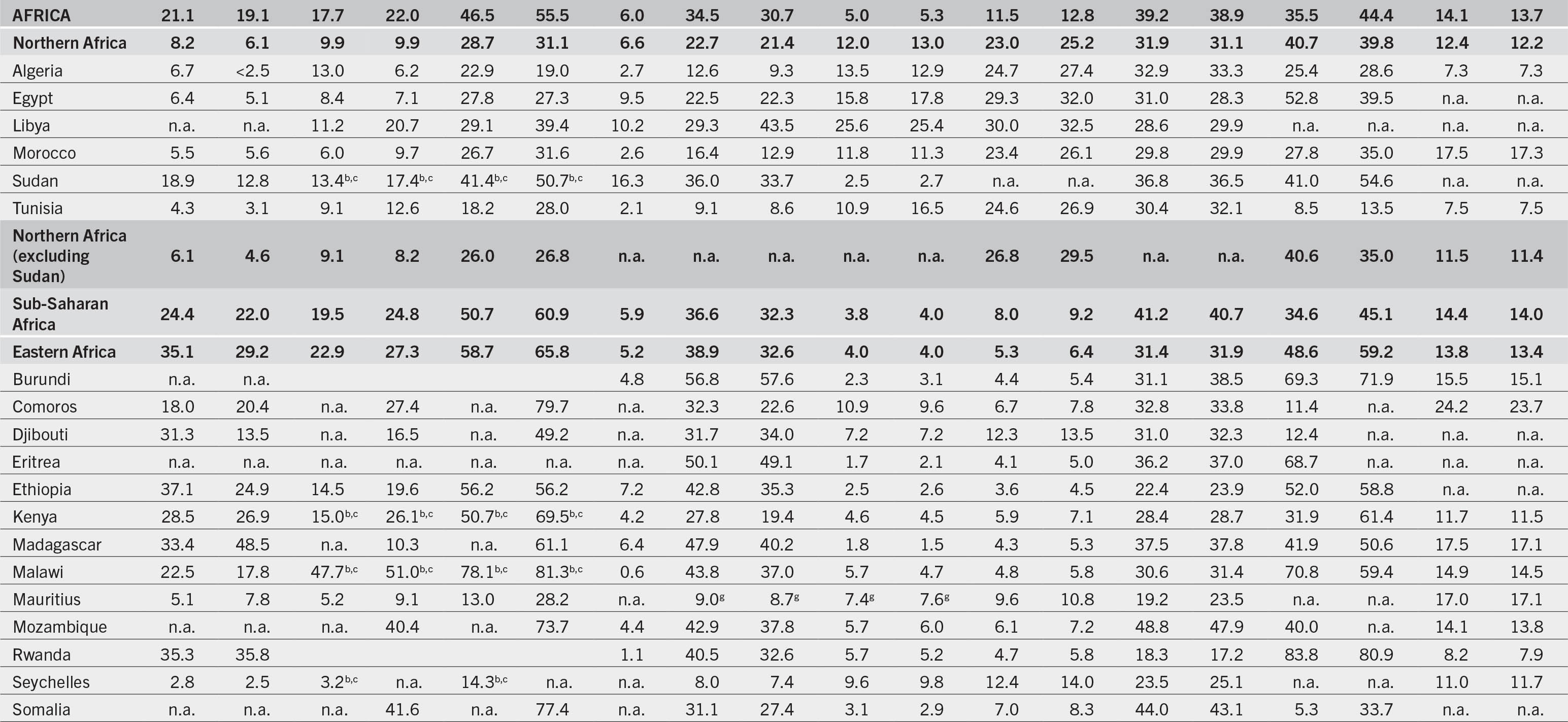

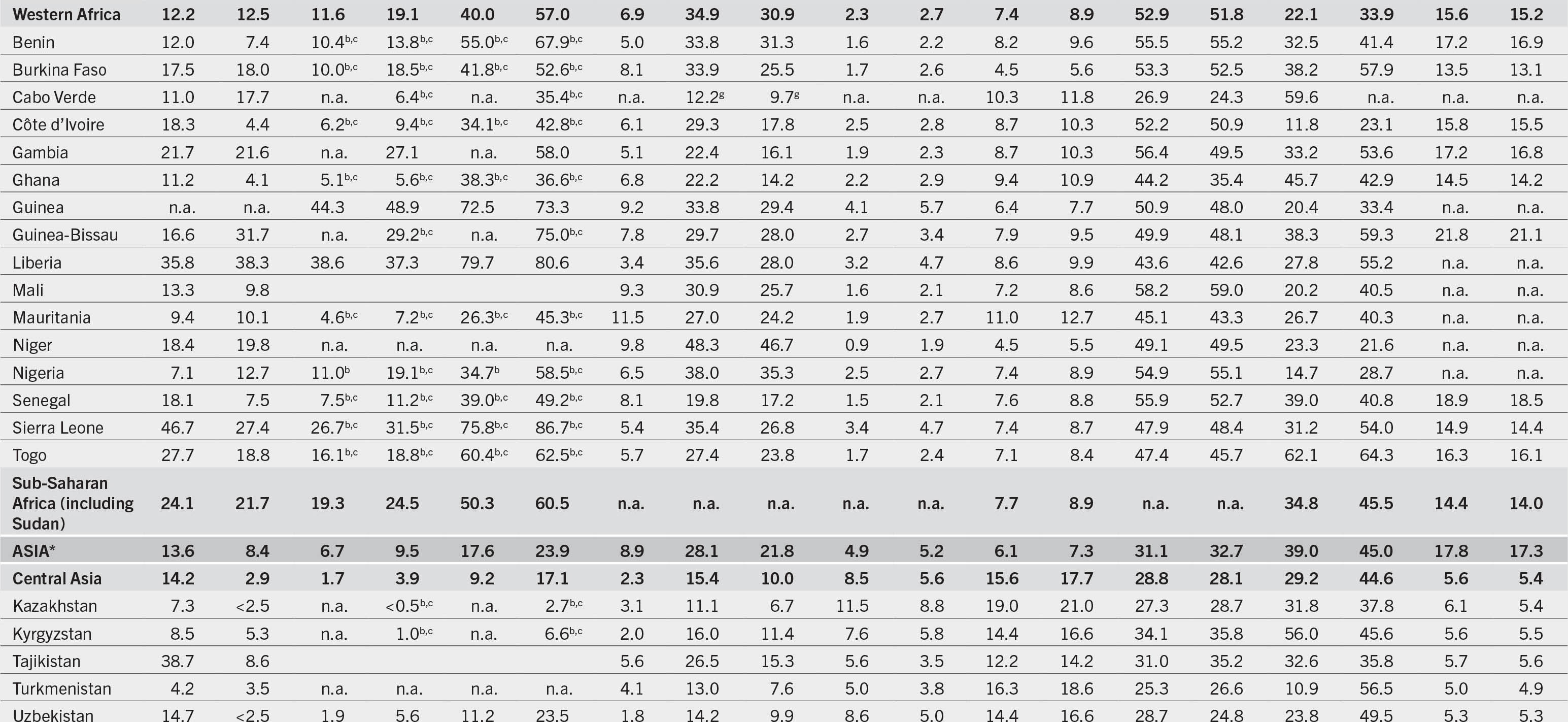

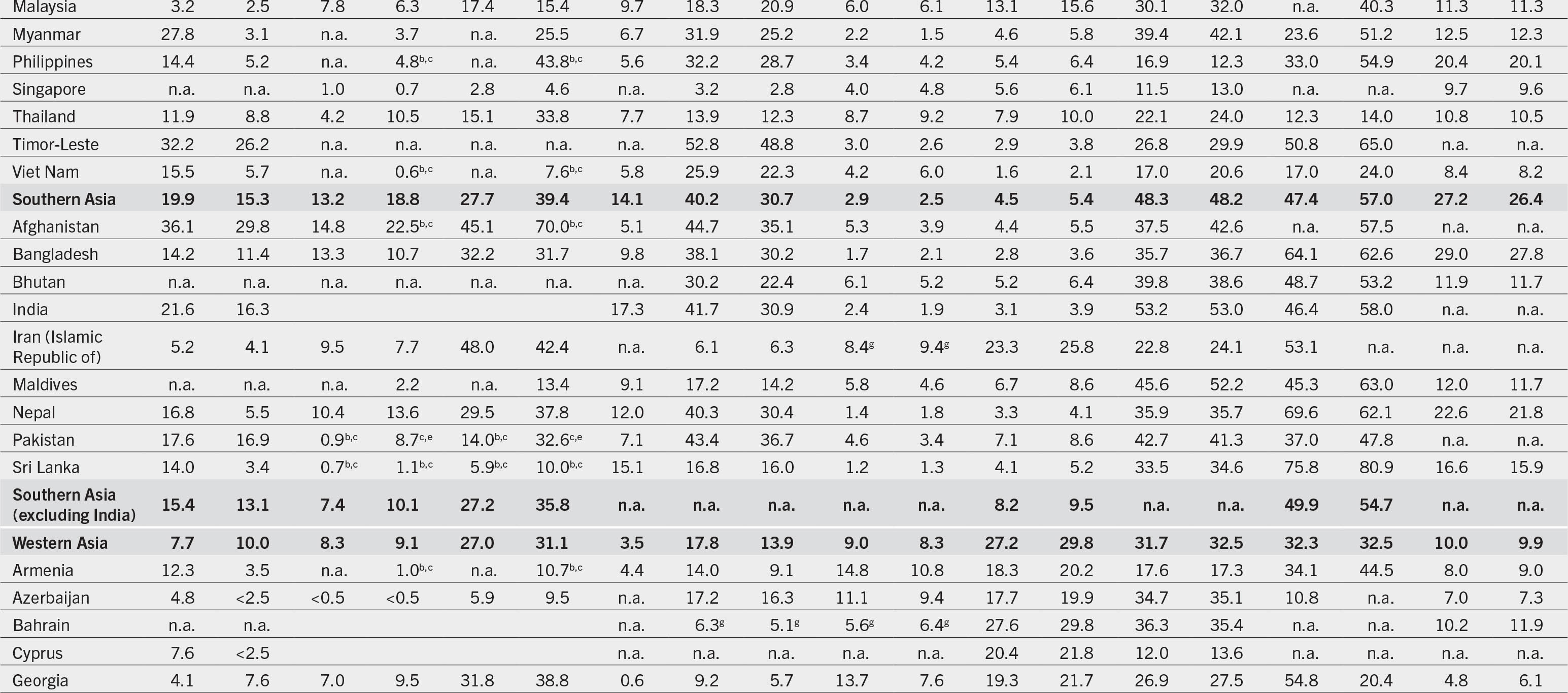
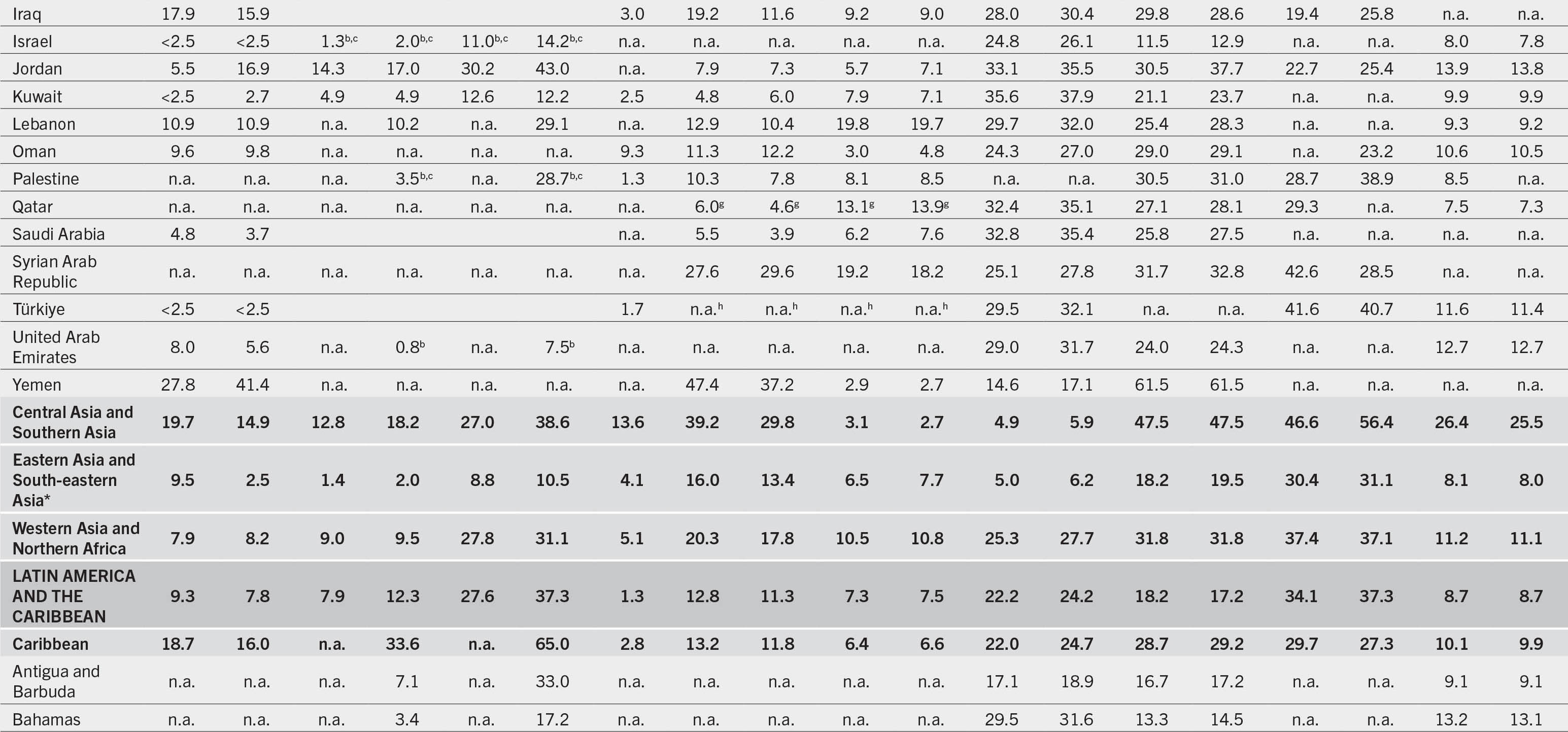
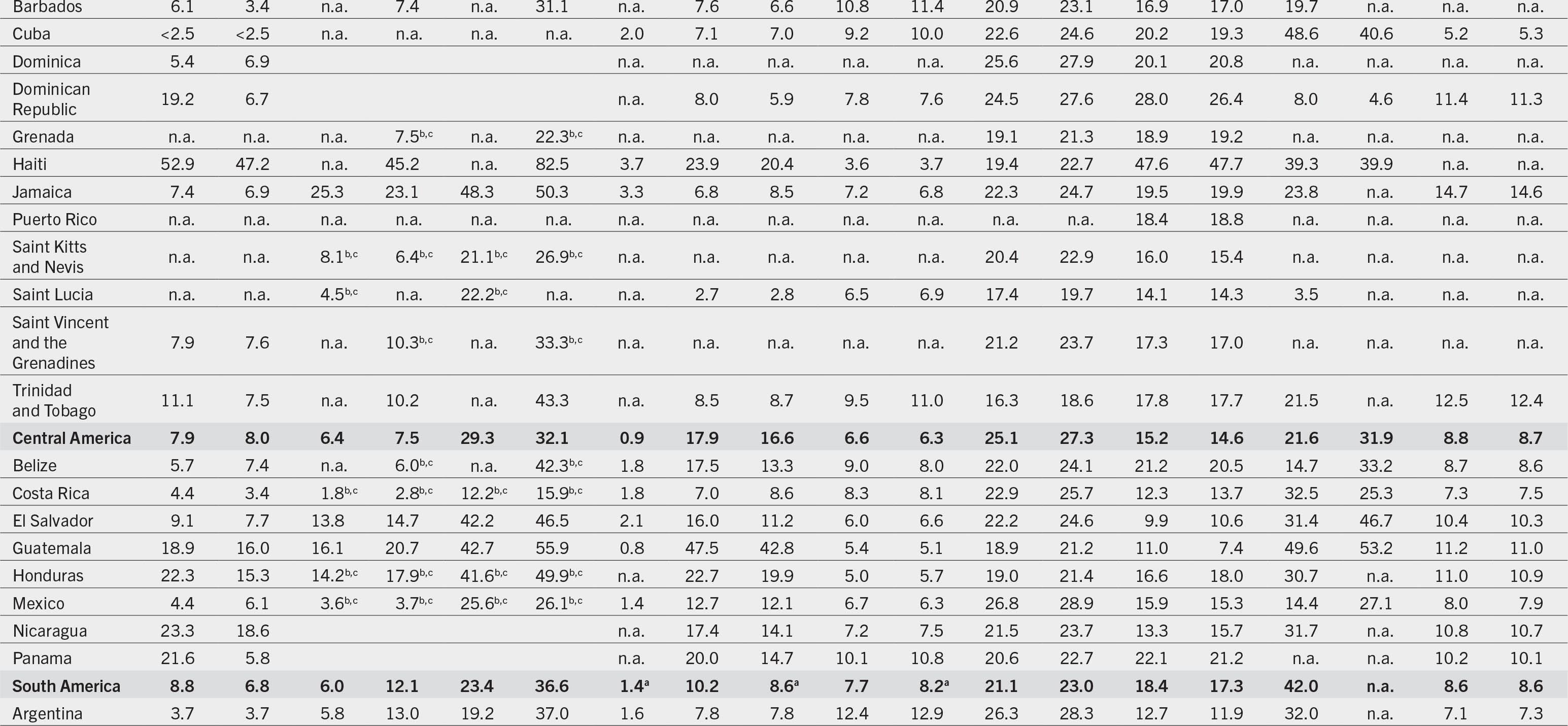
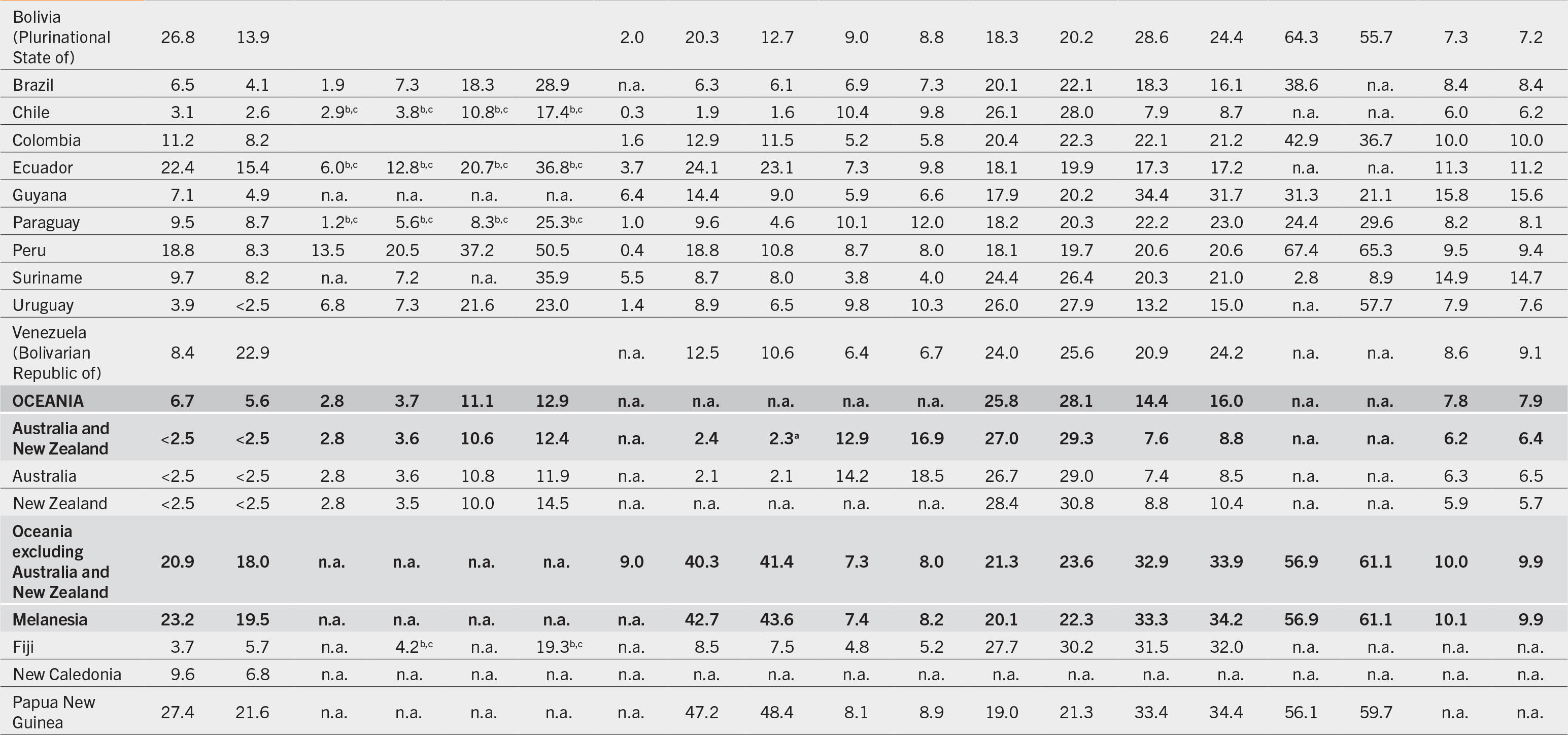
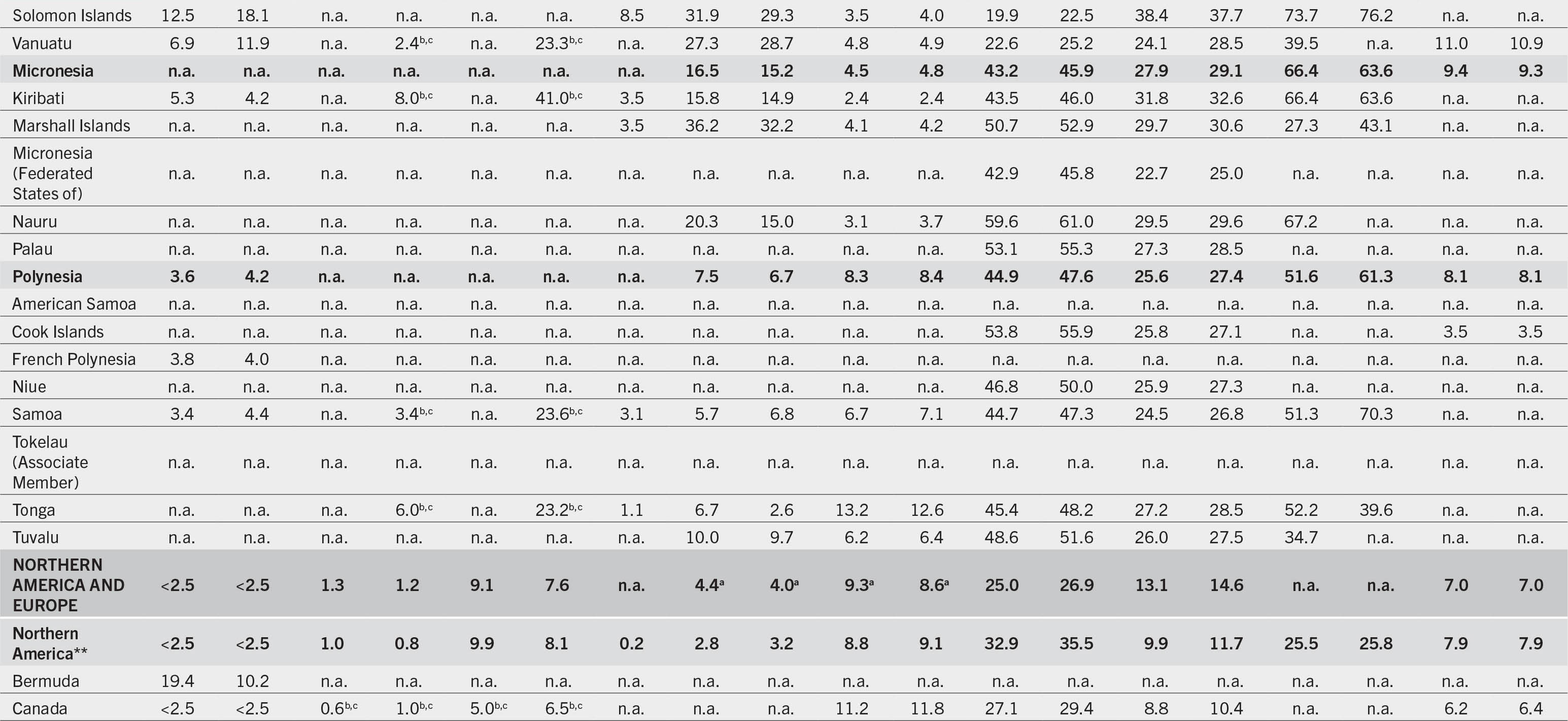

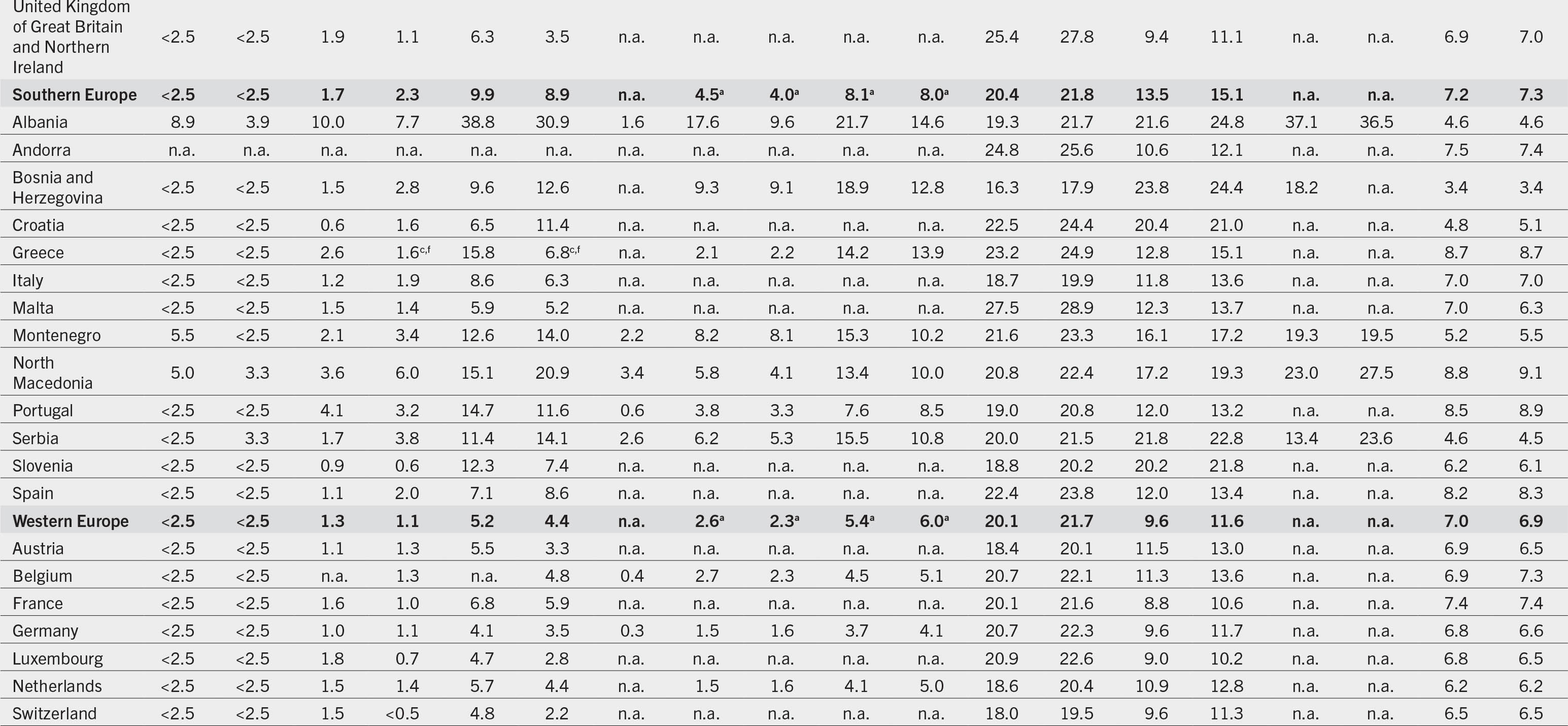
NOTES:
1. Regional estimates were included when more than 50 percent of population was covered. To reduce the margin of error, estimates are presented as three-year averages.
2. FAO estimates of the percentage of people in the total population living in households where at least one adult has been found to be food insecure.
3. Country-level results are presented only for those countries for which estimates are based on official national data (see note c) or as provisional estimates, based on FAO data collected through the Gallup World Poll, Geopoll or Kantar for countries whose national relevant authorities expressed no objection to their publication. Note that consent to publication does not necessarily imply validation of the estimate by the national authorities involved and that the estimate is subject to revision as soon as suitable data from official national sources are available. Global, regional and subregional aggregates are based on data collected in approximately 150 countries.
4. The estimates referring to the middle of the projected ranges for the years 2020 and 2021 were used to calculate the three-year averages.
5. For regional estimates, values correspond to the model predicted estimates for the year 2020. For countries, the latest data available from 2014 to 2020 are used.
6. The collection of household survey data on child height and weight were limited in 2020 due to the physical distancing measures required to prevent the spread of COVID-19. Only four national surveys included in the database were carried out (at least partially) in 2020. The estimates on child stunting, wasting and overweight are therefore based almost entirely on data collected before 2020 and do not take into account the impact of the COVID-19 pandemic.
7. Regional estimates are included when more than 50 percent of population is covered. For countries, the latest data available from 2005 to 2012 are used.
8. Regional estimates are included when more than 50 percent of population is covered. For countries, the latest data available from 2014 to 2020 are used with the exception of China where the latest data are from the year 2013.
* Wasting under 5 years of age and low birthweight regional aggregates exclude Japan.
** The Northern America wasting estimates are derived applying mixed-effect models with subregions as fixed effects; data were available only for the United States of America, preventing the estimation of standard errors (and confidence intervals). Further details on the methodology are described in De Onis, M., Blössner, M., Borghi, E., Frongillo, E.A. & Morris, R. 2004. Estimates of global prevalence of childhood underweight in 1990 and 2015. Journal of the American Medical Association, 291(21): 2600–2606. Model selection is based on best fit.
a. Consecutive low population coverage; interpret with caution.
b. Based on official national data.
c. For years when official national data are not available, the values are projected using FAO data or estimates. See Annex 1B for further details.
d. The food insecurity estimate for 2019 in South Africa is based on the GHS 2019 national survey (prior to the COVID-19 pandemic), pointing to a prevalence of severe food insecurity of 7 percent and a prevalence of moderate or severe food insecurity of 17.3 percent of the national population.
e. Data informing the 2020 food insecurity estimates come from a national COVID-19 impact assessment survey with a reference period of 3 months; therefore, comparability with the rest of the series may be affected.
f. Based on official national data collected in 2019 and 2020 through EU-SILC.
g. Most recent input data are from before 2000, interpret with caution.
h. Pending review.
<2.5 = PoU less than 2.5 percent; <0.5 = prevalence of severe food insecurity less than 0.5 percent.
n.a. = data not available.
1. Regional estimates were included when more than 50 percent of population was covered. To reduce the margin of error, estimates are presented as three-year averages.
2. FAO estimates of the percentage of people in the total population living in households where at least one adult has been found to be food insecure.
3. Country-level results are presented only for those countries for which estimates are based on official national data (see note c) or as provisional estimates, based on FAO data collected through the Gallup World Poll, Geopoll or Kantar for countries whose national relevant authorities expressed no objection to their publication. Note that consent to publication does not necessarily imply validation of the estimate by the national authorities involved and that the estimate is subject to revision as soon as suitable data from official national sources are available. Global, regional and subregional aggregates are based on data collected in approximately 150 countries.
4. The estimates referring to the middle of the projected ranges for the years 2020 and 2021 were used to calculate the three-year averages.
5. For regional estimates, values correspond to the model predicted estimates for the year 2020. For countries, the latest data available from 2014 to 2020 are used.
6. The collection of household survey data on child height and weight were limited in 2020 due to the physical distancing measures required to prevent the spread of COVID-19. Only four national surveys included in the database were carried out (at least partially) in 2020. The estimates on child stunting, wasting and overweight are therefore based almost entirely on data collected before 2020 and do not take into account the impact of the COVID-19 pandemic.
7. Regional estimates are included when more than 50 percent of population is covered. For countries, the latest data available from 2005 to 2012 are used.
8. Regional estimates are included when more than 50 percent of population is covered. For countries, the latest data available from 2014 to 2020 are used with the exception of China where the latest data are from the year 2013.
* Wasting under 5 years of age and low birthweight regional aggregates exclude Japan.
** The Northern America wasting estimates are derived applying mixed-effect models with subregions as fixed effects; data were available only for the United States of America, preventing the estimation of standard errors (and confidence intervals). Further details on the methodology are described in De Onis, M., Blössner, M., Borghi, E., Frongillo, E.A. & Morris, R. 2004. Estimates of global prevalence of childhood underweight in 1990 and 2015. Journal of the American Medical Association, 291(21): 2600–2606. Model selection is based on best fit.
a. Consecutive low population coverage; interpret with caution.
b. Based on official national data.
c. For years when official national data are not available, the values are projected using FAO data or estimates. See Annex 1B for further details.
d. The food insecurity estimate for 2019 in South Africa is based on the GHS 2019 national survey (prior to the COVID-19 pandemic), pointing to a prevalence of severe food insecurity of 7 percent and a prevalence of moderate or severe food insecurity of 17.3 percent of the national population.
e. Data informing the 2020 food insecurity estimates come from a national COVID-19 impact assessment survey with a reference period of 3 months; therefore, comparability with the rest of the series may be affected.
f. Based on official national data collected in 2019 and 2020 through EU-SILC.
g. Most recent input data are from before 2000, interpret with caution.
h. Pending review.
<2.5 = PoU less than 2.5 percent; <0.5 = prevalence of severe food insecurity less than 0.5 percent.
n.a. = data not available.
TABLE A1.2PROGRESS TOWARDS THE SUSTAINABLE DEVELOPMENT GOALS (SDGs) AND GLOBAL NUTRITION TARGETS: NUMBER OF PEOPLE WHO ARE AFFECTED BY UNDERNOURISHMENT, MODERATE OR SEVERE FOOD INSECURITY AND SELECTED FORMS OF MALNUTRITION; NUMBER OF INFANTS EXCLUSIVELY BREASTFED AND NUMBER OF BABIES BORN WITH LOW BIRTHWEIGHT
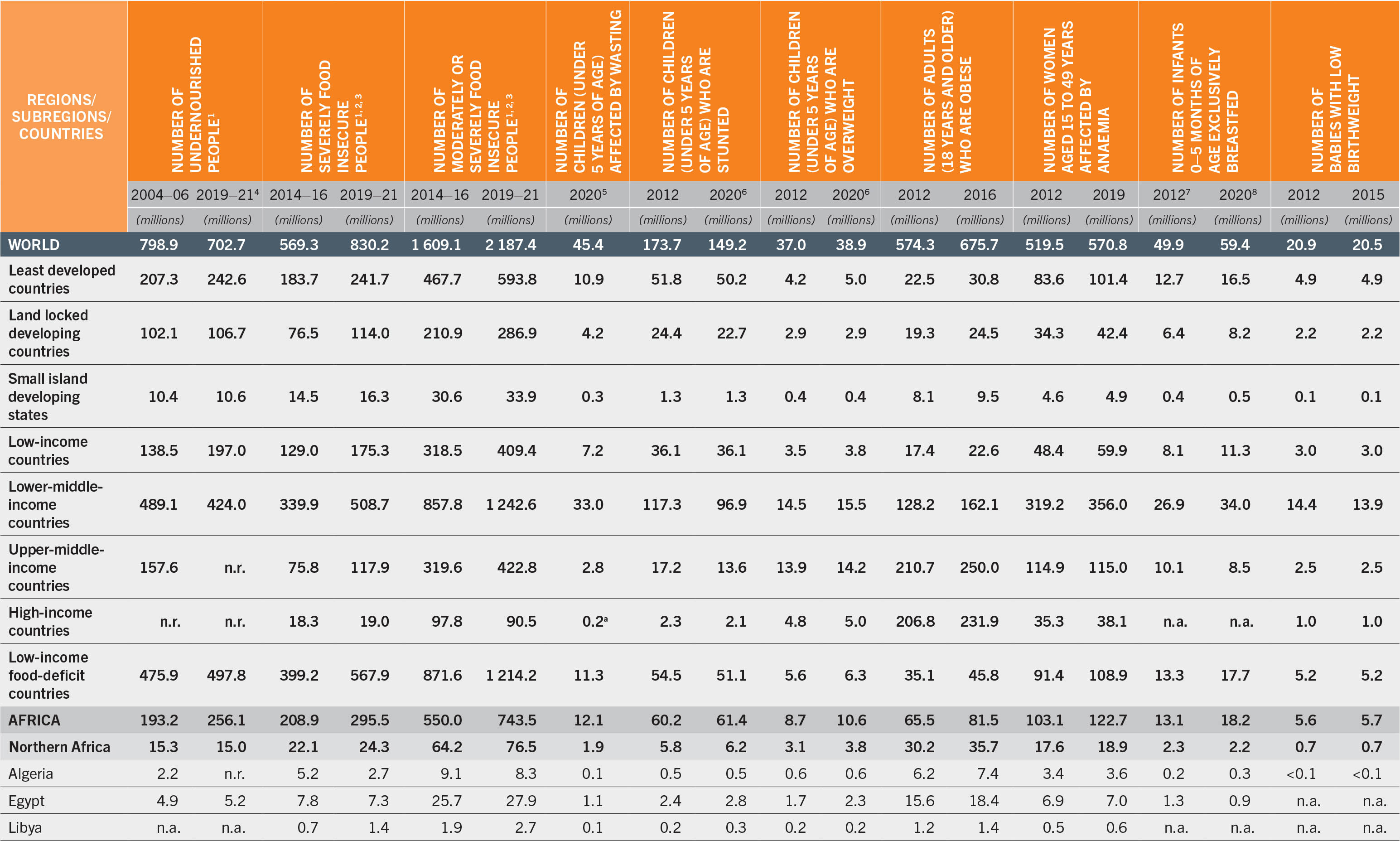
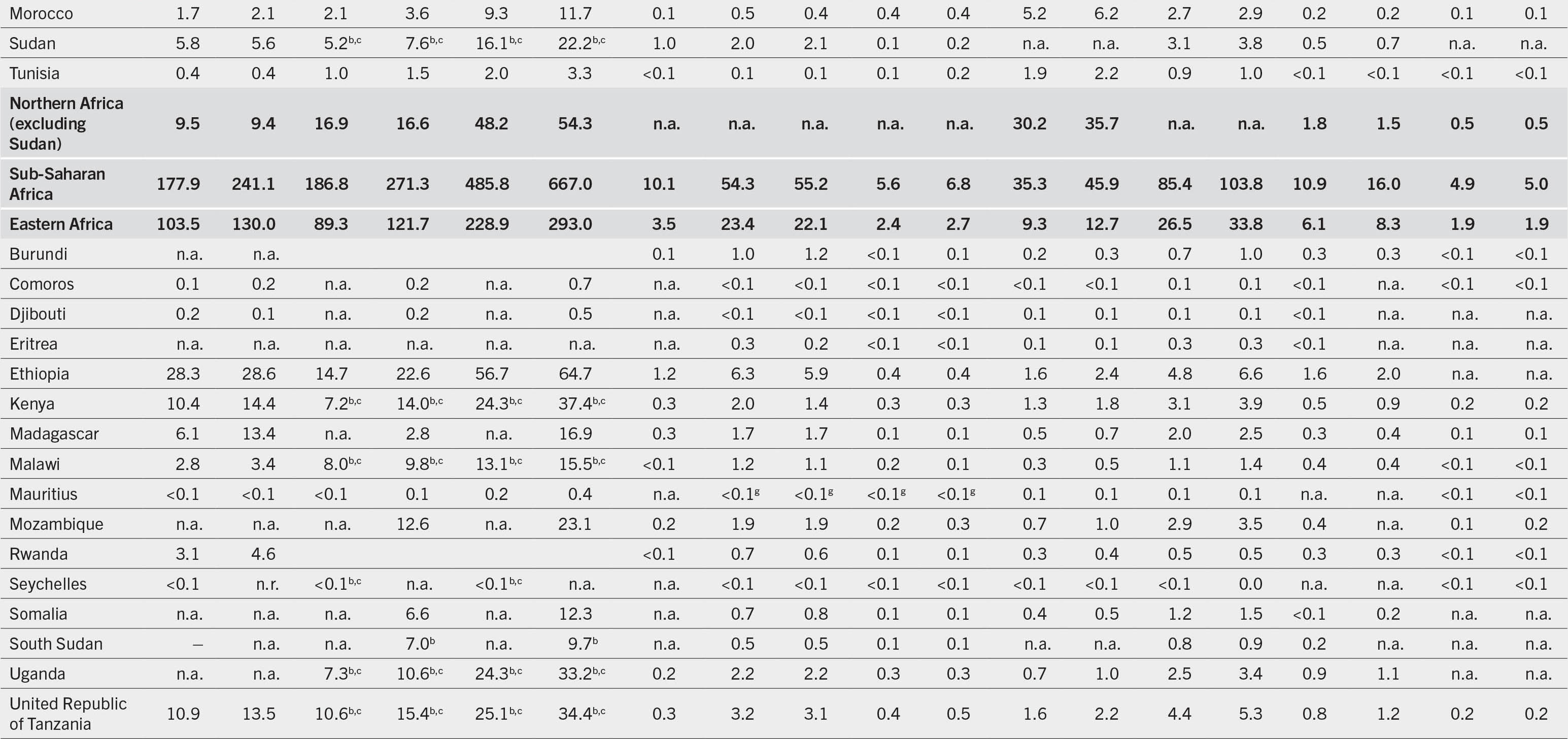
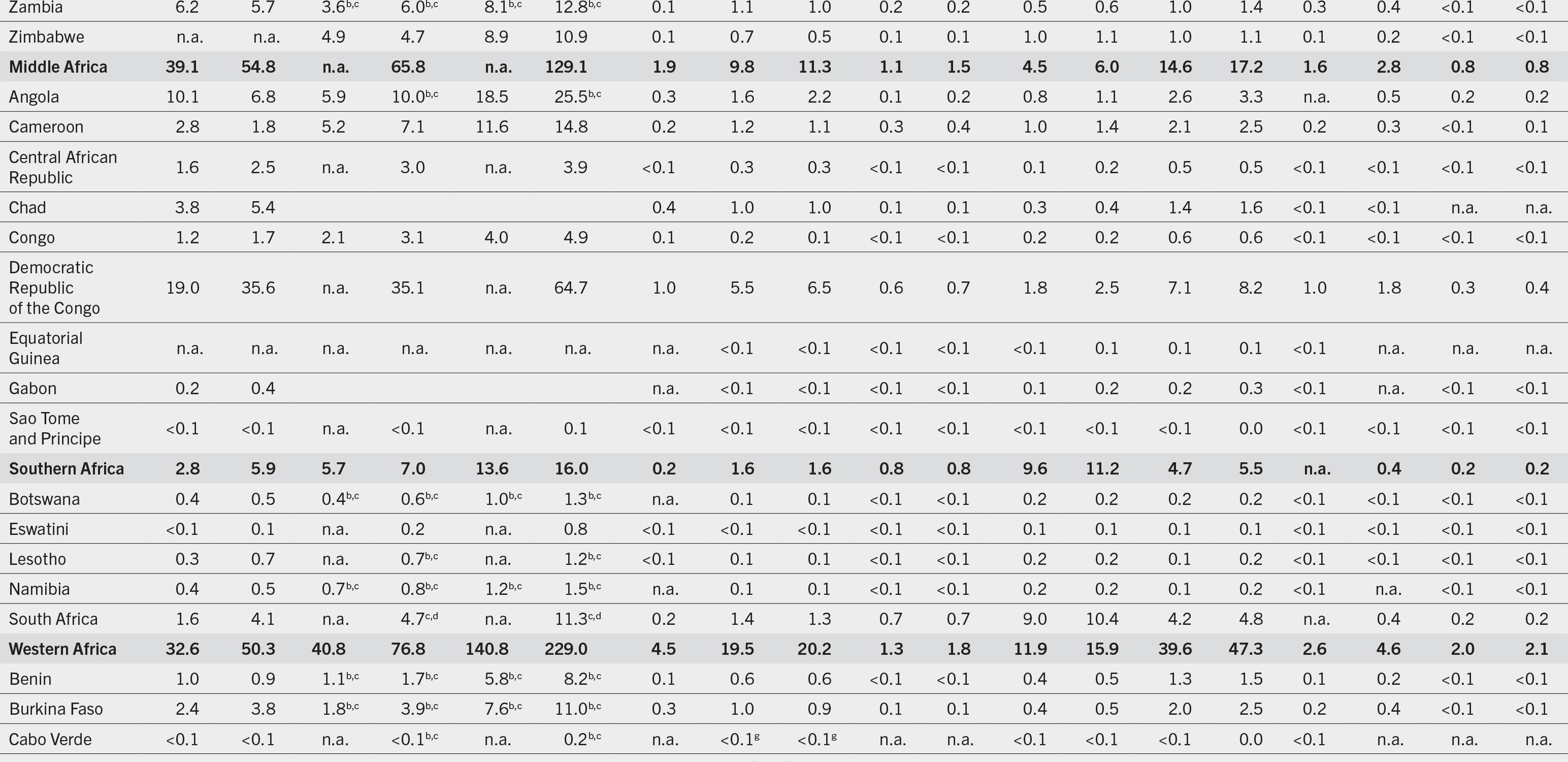
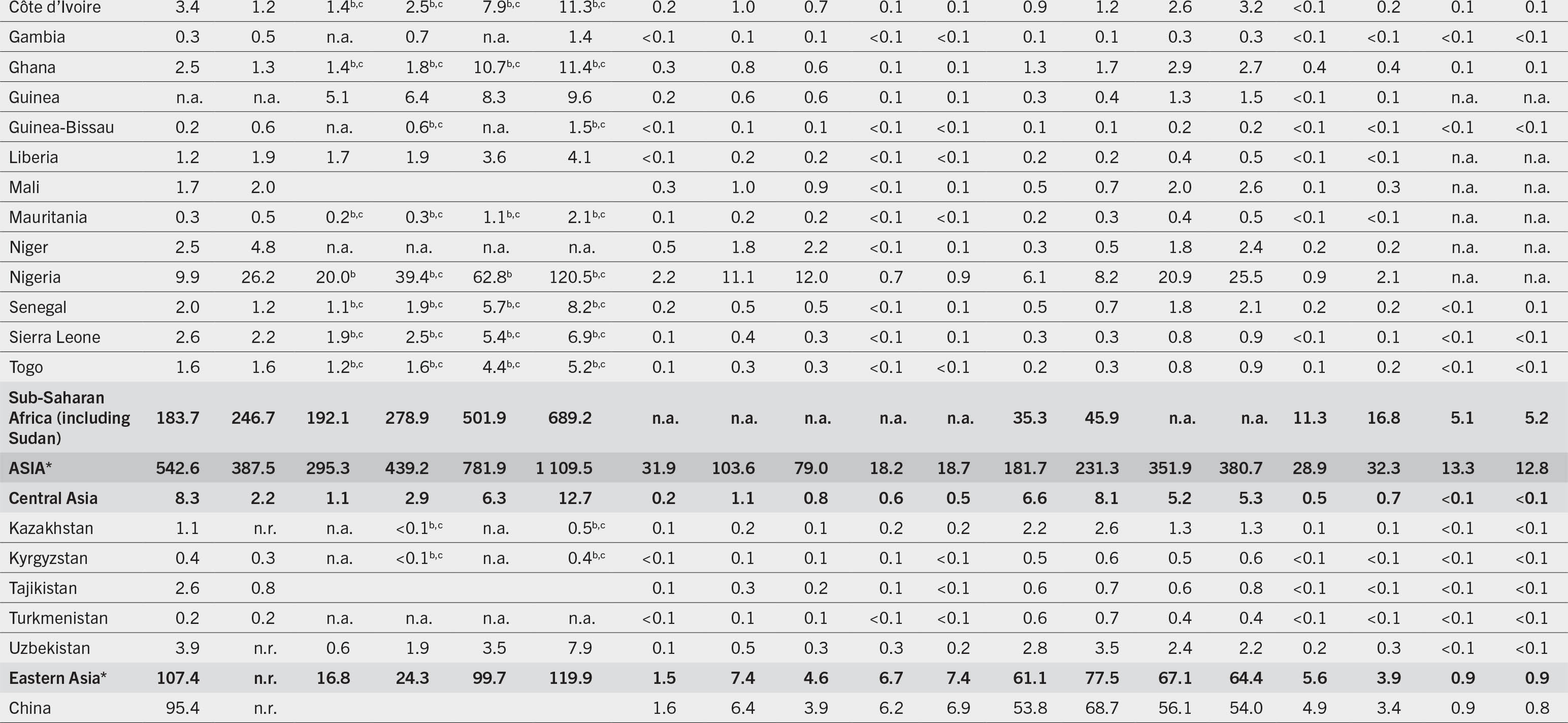


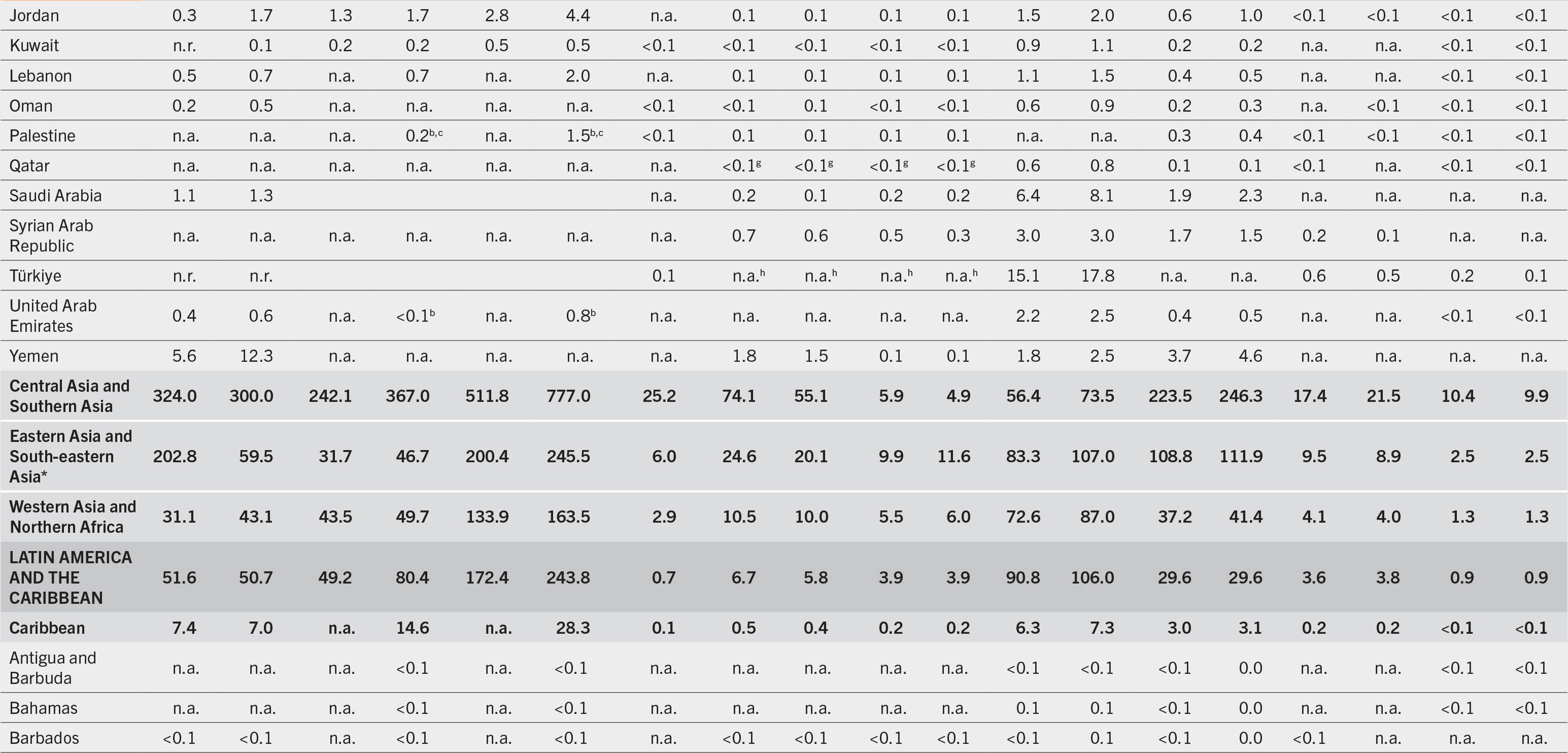

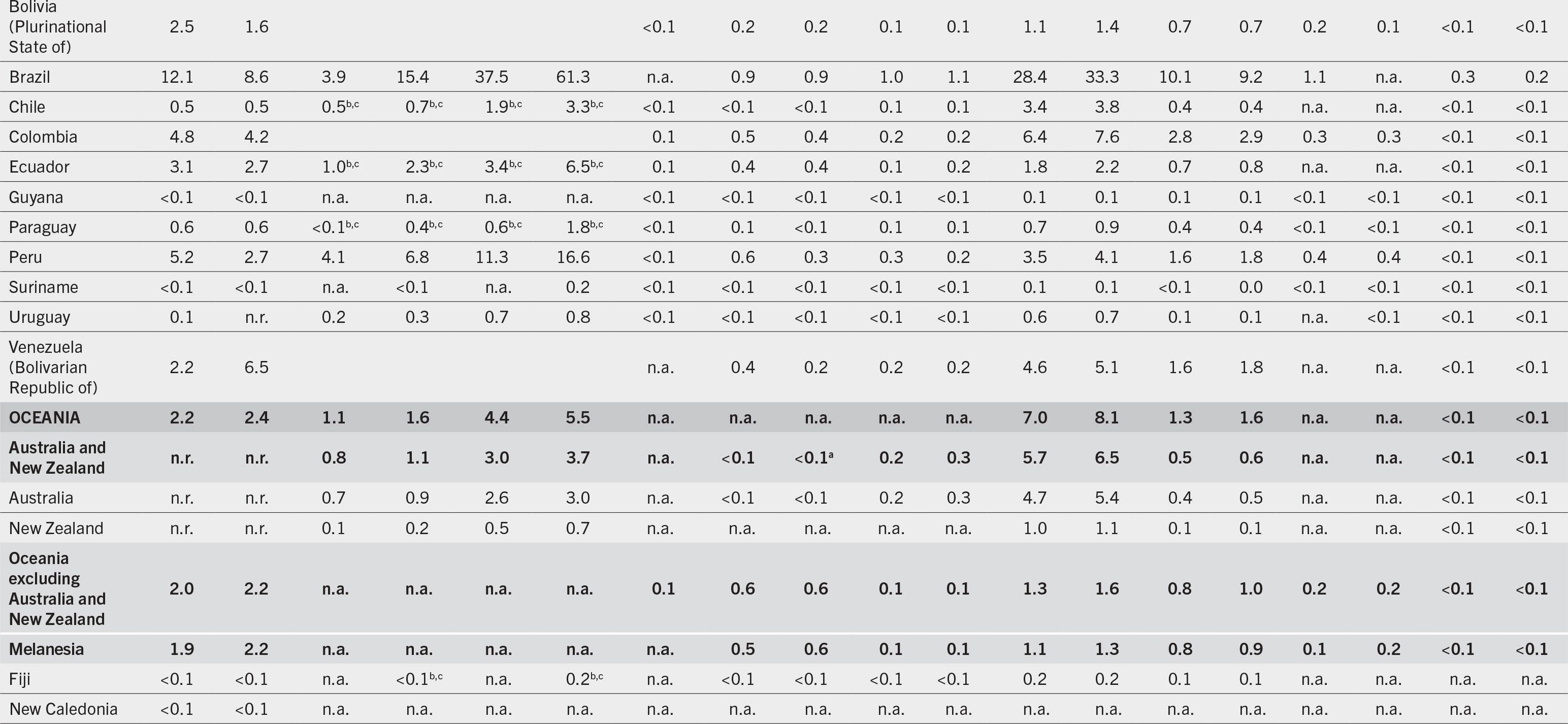
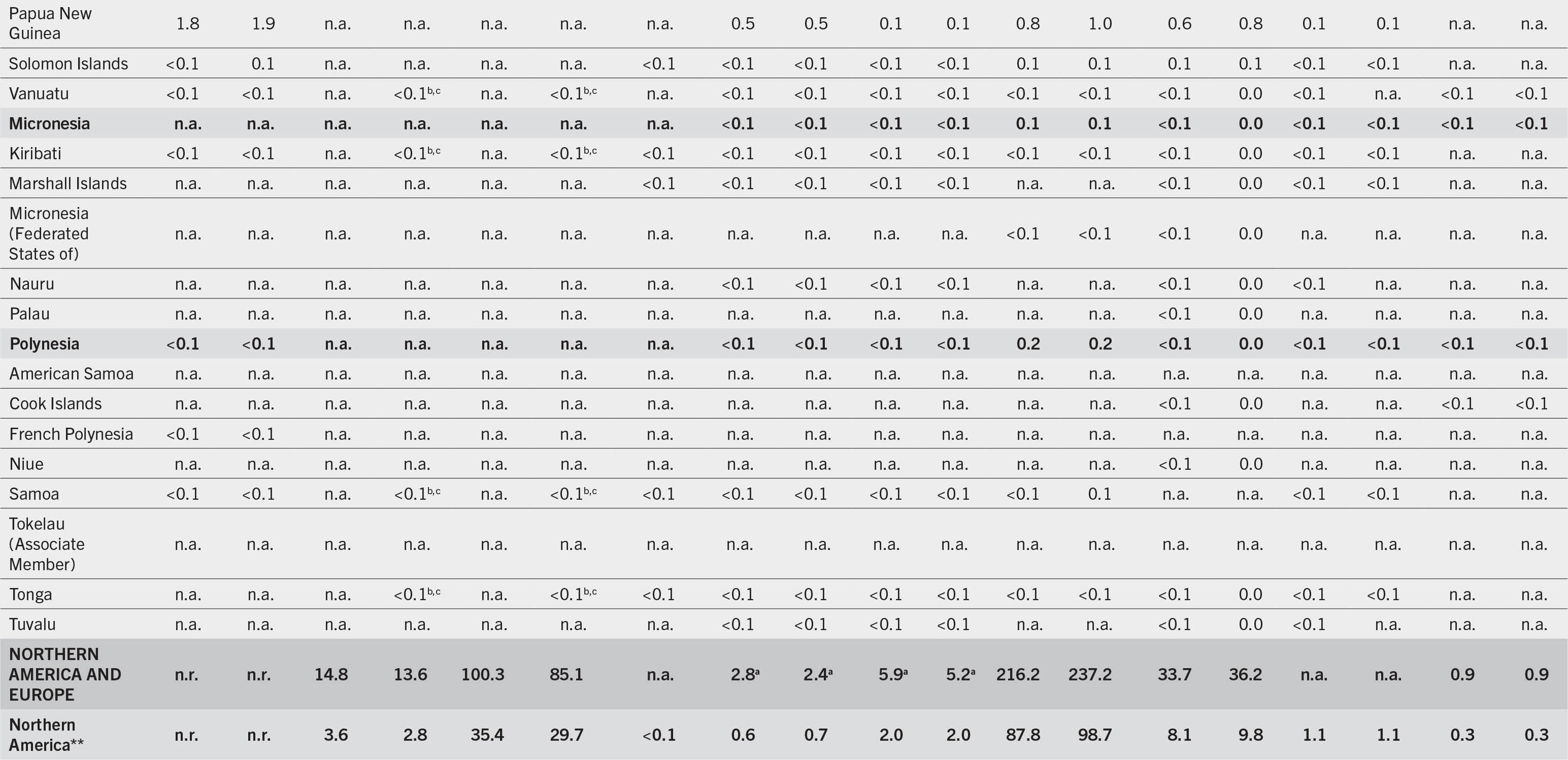
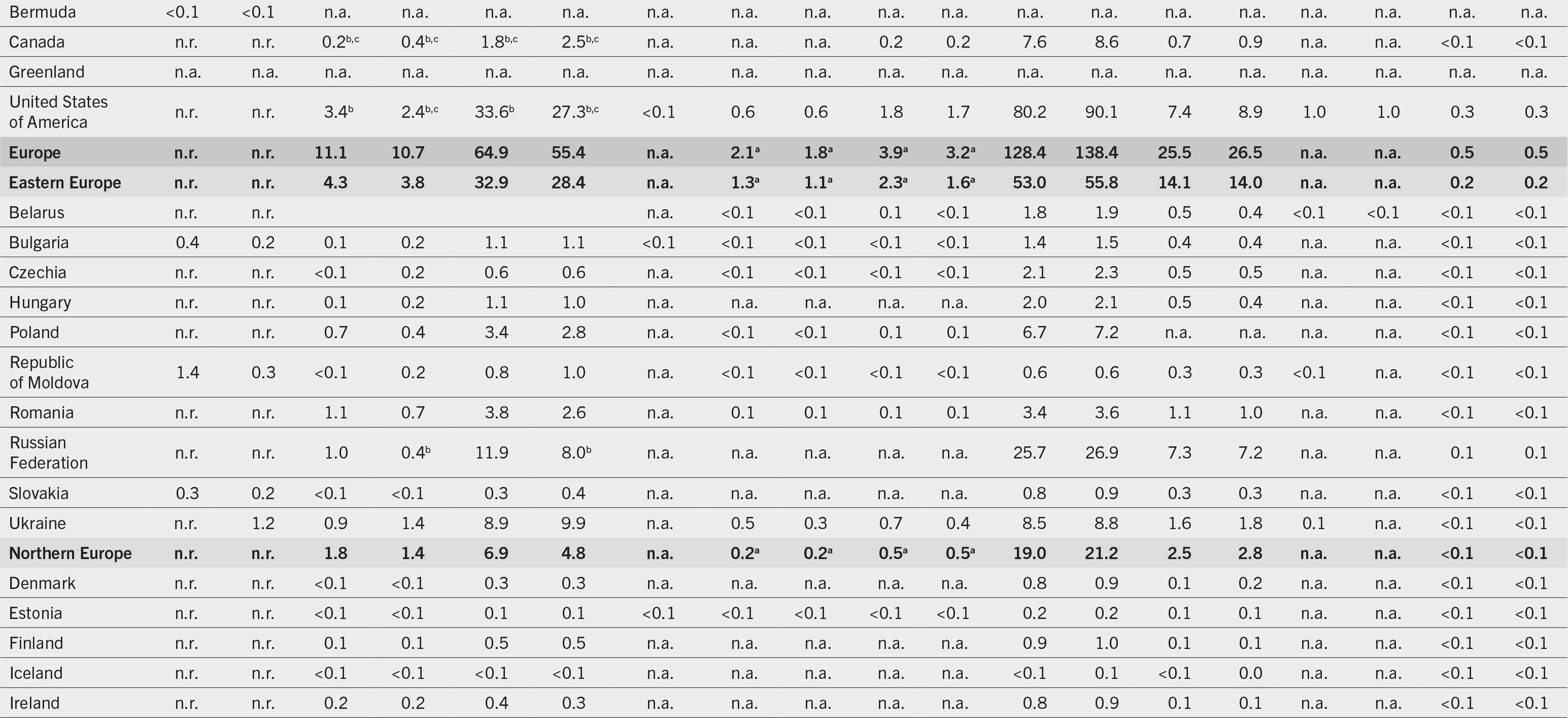


NOTES:
1. Regional estimates were included when more than 50 percent of population was covered. To reduce the margin of error, estimates are presented as three-year averages.
2. FAO estimates of the number of people living in households where at least one adult has been found to be food insecure.
3. Country-level results are presented only for those countries for which estimates are based on official national data (see note c) or as provisional estimates, based on FAO data collected through the Gallup World Poll, Geopoll or Kantar for countries whose national relevant authorities expressed no objection to their publication. Note that consent to publication does not necessarily imply validation of the estimate by the national authorities involved and that the estimate is subject to revision as soon as suitable data from official national sources are available. Global, regional and subregional aggregates are based on data collected in approximately 150 countries.
4. The estimates referring to the middle of the projected ranges for the years 2020 and 2021 were used to calculate the three-year averages.
5. For regional estimates, values correspond to the model predicted estimates for the year 2020. For countries, the latest data available from 2014 to 2020 are used.
6. The collection of household survey data on child height and weight were limited in 2020 due to the physical distancing measures required to prevent the spread of COVID-19. Only four national surveys included in the database were carried out (at least partially) in 2020. The estimates on child stunting, wasting and overweight are therefore based almost entirely on data collected before 2020 and do not take into account the impact of the COVID-19 pandemic.
7. Regional estimates are included when more than 50 percent of population is covered. For countries, the latest data available from 2005 to 2012 are used.
8. Regional estimates are included when more than 50 percent of population is covered. For countries, the latest data available from 2014 to 2020 are used with the exception of China where the latest data are from the year 2013.
* Wasting under 5 years of age and low birthweight regional aggregates exclude Japan.
** The Northern America wasting estimates are derived applying mixed-effect models with subregions as fixed effects; data were available only for the United States of America, preventing the estimation of standard errors (and confidence intervals). Further details on the methodology are described in De Onis, M., Blössner, M., Borghi, E., Frongillo, E.A. & Morris, R. 2004. Estimates of global prevalence of childhood underweight in 1990 and 2015. Journal of the American Medical Association, 291(21): 2600–2606. Model selection is based on best fit.
a. Consecutive low population coverage; interpret with caution.
b. Based on official national data.
c. For years when official national data are not available, the values are projected using FAO data or estimates. See Annex 1B for further details.
d. The food insecurity estimate for 2019 in South Africa is based on the GHS 2019 national survey (prior to the COVID-19 pandemic), pointing to a prevalence of severe food insecurity of 7 percent and a prevalence of moderate or severe food insecurity of 17.3 percent of the national population.
e. Data informing the 2020 food insecurity estimates come from a national COVID-19 impact assessment survey with a reference period of 3 months; therefore, comparability with the rest of the series may be affected.
f. Based on official national data collected in 2019 and 2020 through EU-SILC.
g. Most recent input data are from before 2000, interpret with caution.
h. Pending review.
<0.1 = less than 100 000 people.
n.a. = data not available.
n.r. = data not reported as the prevalence is less than 2.5 percent.
1. Regional estimates were included when more than 50 percent of population was covered. To reduce the margin of error, estimates are presented as three-year averages.
2. FAO estimates of the number of people living in households where at least one adult has been found to be food insecure.
3. Country-level results are presented only for those countries for which estimates are based on official national data (see note c) or as provisional estimates, based on FAO data collected through the Gallup World Poll, Geopoll or Kantar for countries whose national relevant authorities expressed no objection to their publication. Note that consent to publication does not necessarily imply validation of the estimate by the national authorities involved and that the estimate is subject to revision as soon as suitable data from official national sources are available. Global, regional and subregional aggregates are based on data collected in approximately 150 countries.
4. The estimates referring to the middle of the projected ranges for the years 2020 and 2021 were used to calculate the three-year averages.
5. For regional estimates, values correspond to the model predicted estimates for the year 2020. For countries, the latest data available from 2014 to 2020 are used.
6. The collection of household survey data on child height and weight were limited in 2020 due to the physical distancing measures required to prevent the spread of COVID-19. Only four national surveys included in the database were carried out (at least partially) in 2020. The estimates on child stunting, wasting and overweight are therefore based almost entirely on data collected before 2020 and do not take into account the impact of the COVID-19 pandemic.
7. Regional estimates are included when more than 50 percent of population is covered. For countries, the latest data available from 2005 to 2012 are used.
8. Regional estimates are included when more than 50 percent of population is covered. For countries, the latest data available from 2014 to 2020 are used with the exception of China where the latest data are from the year 2013.
* Wasting under 5 years of age and low birthweight regional aggregates exclude Japan.
** The Northern America wasting estimates are derived applying mixed-effect models with subregions as fixed effects; data were available only for the United States of America, preventing the estimation of standard errors (and confidence intervals). Further details on the methodology are described in De Onis, M., Blössner, M., Borghi, E., Frongillo, E.A. & Morris, R. 2004. Estimates of global prevalence of childhood underweight in 1990 and 2015. Journal of the American Medical Association, 291(21): 2600–2606. Model selection is based on best fit.
a. Consecutive low population coverage; interpret with caution.
b. Based on official national data.
c. For years when official national data are not available, the values are projected using FAO data or estimates. See Annex 1B for further details.
d. The food insecurity estimate for 2019 in South Africa is based on the GHS 2019 national survey (prior to the COVID-19 pandemic), pointing to a prevalence of severe food insecurity of 7 percent and a prevalence of moderate or severe food insecurity of 17.3 percent of the national population.
e. Data informing the 2020 food insecurity estimates come from a national COVID-19 impact assessment survey with a reference period of 3 months; therefore, comparability with the rest of the series may be affected.
f. Based on official national data collected in 2019 and 2020 through EU-SILC.
g. Most recent input data are from before 2000, interpret with caution.
h. Pending review.
<0.1 = less than 100 000 people.
n.a. = data not available.
n.r. = data not reported as the prevalence is less than 2.5 percent.




